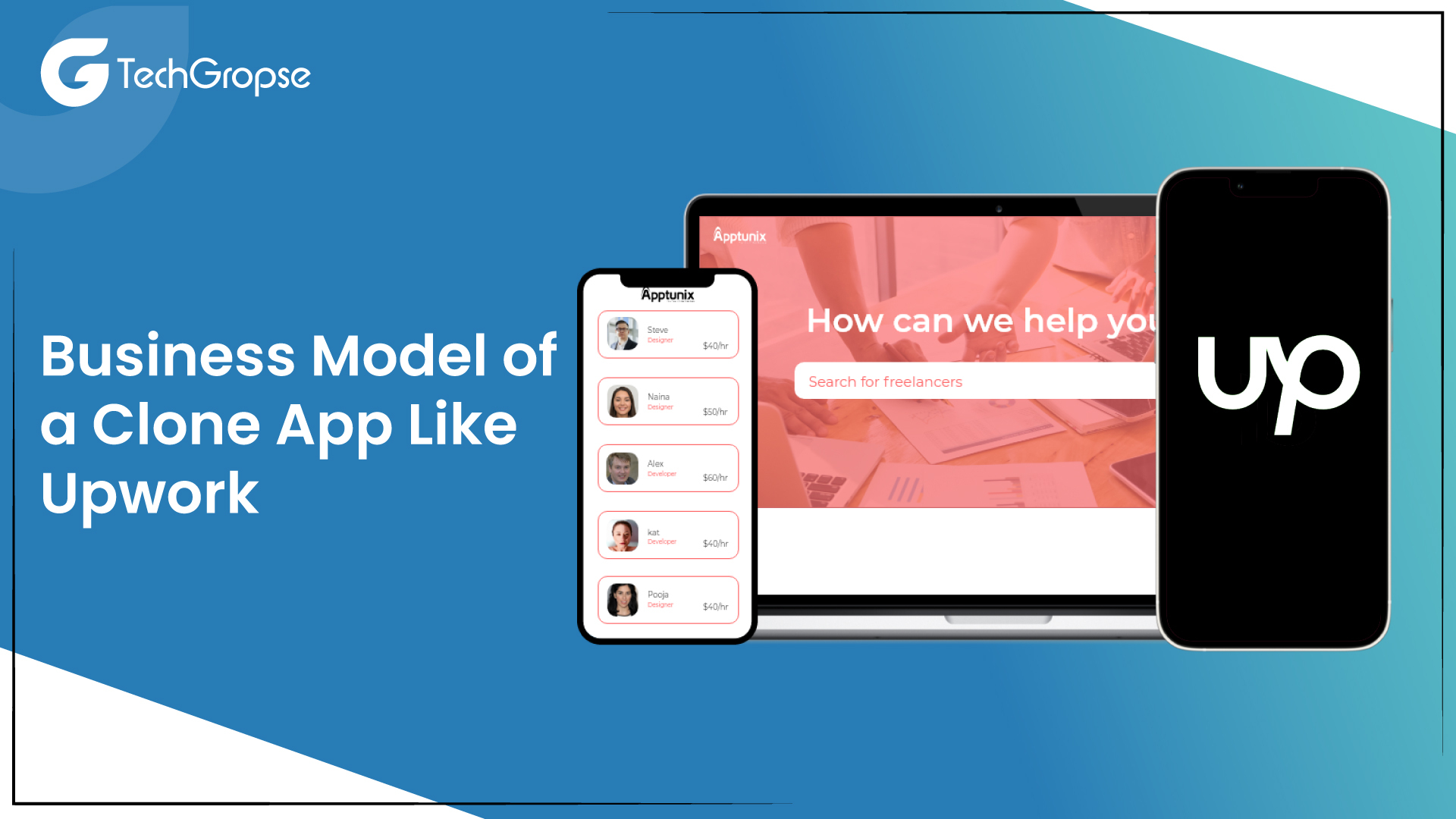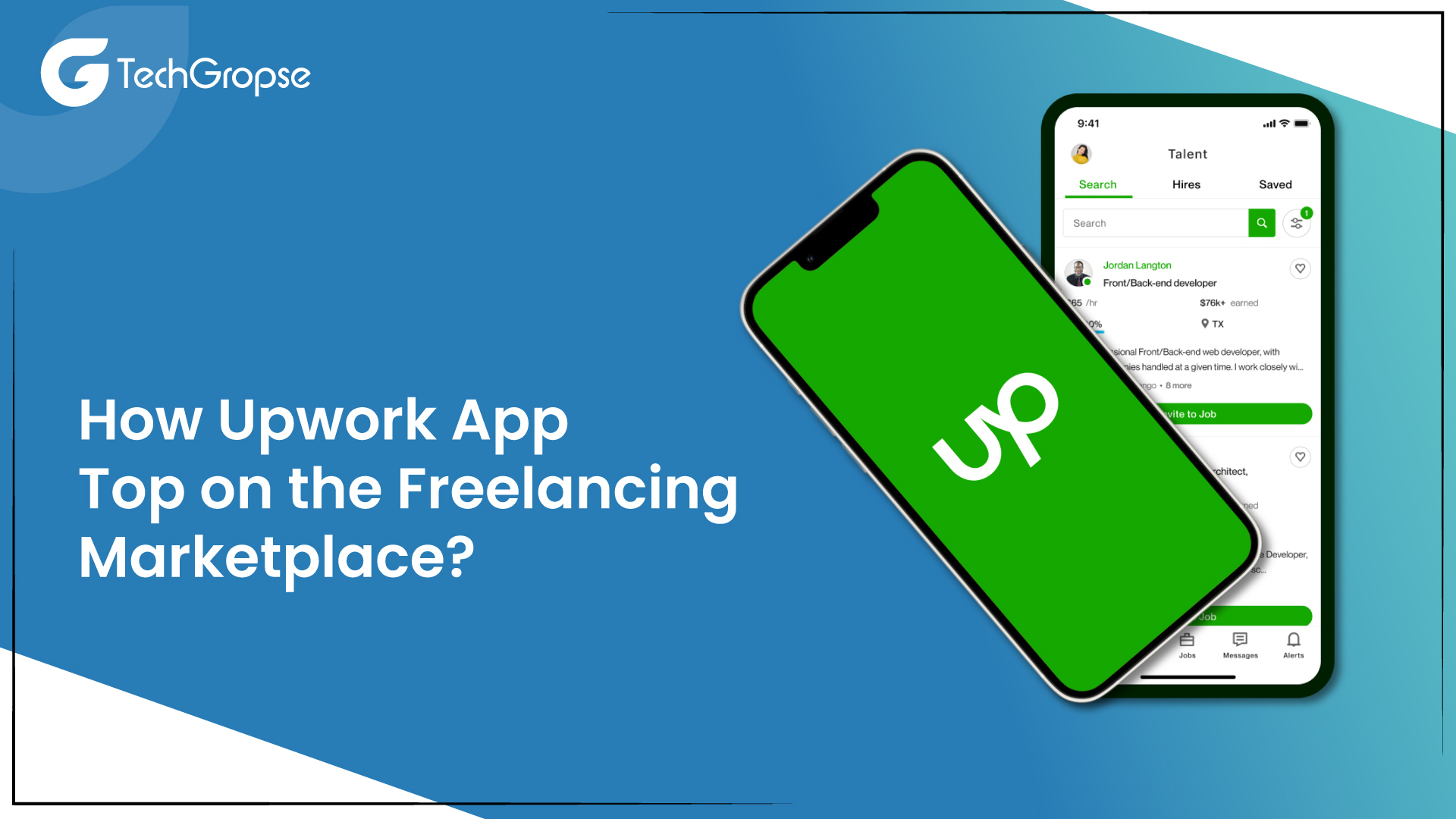When you think about freelance work online, you probably think of Upwork, right? Upwork, one of the leading freelance platforms, has gained immense popularity by providing a platform for freelancers and clients to find each other. If you are fascinated by the success of Upwork and want to build an Upwork Clone app, this post will guide you through the process of building an Upwork clone app.
Once known as Elance-oDesk, now Upwork reigns as the planet’s biggest online hub for freelancers and clients. Boasting over 12 million freelancers and 5 million clients globally, it dominates the freelancing scene, raking in a whopping $502 million in annual gross services volume in 2021.
The freelance giant, Upwork, smoothly caters to a massive community of 800,000 active users. These include freelancers and talent seekers worldwide, spanning diverse industries. It’s a go-to platform connecting people from all corners of the globe efficiently.
So, are you looking to build an Upwork clone app? Let’s move into the essential details of developing an online freelance marketplace app along with its essential features and development costs.
What is Upwork and Why Clone it?
You have probably heard of Upwork, the popular freelance marketplace that connects businesses with talented freelancers from around the world. It’s a platform that revolutionized the way people work and opened up endless opportunities for both freelancers and businesses.
So, why would someone want to build an app like Upwork? Well, building an Upwork clone app allows you to create your freelance marketplace tailored to your specific needs. You can customize it, add unique features, and even target a niche market that Upwork might not cater to.
Why You Should Build an App Like Upwork?
Let’s check out some amazing numbers to see why now is an awesome time to invest in an Upwork clone app.
So, there are three big players in freelance marketplace development: Upwork, Freelancer, and Fiverr. They make up most of the total market value.
Upwork is like the king with a global market worth $1.3 trillion. And right after Upwork, we have Fiverr with a market value of $750 billion.
According to Verified Market Research, the freelance marketplace was worth $3.8 billion in 2020.
It’s growing at a rate of 15.02% every year. That means it’s expected to grow by a whopping $12 billion from 2021 to 2028.
So, with all these numbers pointing in the same direction, it’s clear that investing in an app like Upwork right now could be a smart move.
What is the Business Model of a Clone App Like Upwork?
A clone app like Upwork, inspired by the success of the original platform, operates on a dynamic online employment marketplace catering to the growing trend of freelancers seeking flexibility in their work. This digital transformation empowers individuals to make choices about
- What they work
- How they work
- When they work
- Where they work
The primary customer segments in this freelance marketplace are
Freelancers
- Individuals with specific skill sets.
- Benefits include powerful marketing channels, access to reputable clients, secured and timely payments, flexible work schedules from remote locations, and real-time visibility into high-demand opportunities.
Clients
- Entities seeking freelance services.
- Benefits include fast, secure, and efficient access to high-quality talent spanning over 10,000 skills across 90+ categories.
- The platform facilitates a direct-to-talent approach to hire mobile app developer, streamlining the entire workflow from talent sourcing to contract completion.
Benefits of the Upwork Clone Business Model
- Remote Engagements: Enables clients to engage with freelancers remotely.
- Time Tracking: Provides tools for tracking work hours and progress.
- Invoicing: Streamlines the invoicing process for seamless transactions.
- Payments: Ensures swift and secure payment processes.
- Communication: Facilitates efficient communication between freelancers and clients.
- Collaboration: Offers tools for collaborative work on projects.
By replicating the success factors of Upwork, the clone platform aims to create a thriving freelance ecosystem where both freelancers and clients benefit from a flexible, efficient, and secure marketplace for talent exchange.
Step to Build an Upwork Clone App

As we discussed above, the freelance industry has been booming in recent years, with an increasing number of professionals choosing to work independently.
As a result, the demand for freelance marketplaces like Upwork has grown significantly. However, building a freelance marketplace from scratch can be time-consuming and expensive.
That’s where an Upwork clone app comes in handy. It provides a ready-to-use solution that allows entrepreneurs to quickly launch their Upwork app development without the hassle of building everything from the ground up.
If you plan to build an Upwork clone involve a comprehensive approach, focusing on user experience, security, and scalability to create a successful freelance services marketplace.
Let’s Start
1. Market Research and Analysis
Before diving into developing your Fiverr clone app, it’s crucial to conduct thorough market research and analysis. It will help you understand the current freelance marketplace landscape, identify your target audience, and uncover any gaps or opportunities for your app. By gathering insights and data, you can make informed decisions about the features and functionalities your app should offer.
2. Wireframing and Prototyping
Once you have a clear understanding of your target audience and marketplace dynamics, it’s time to create wireframes and prototypes to build Upwork clone app. Wireframing allows you to visualize the layout and structure of your app, while prototyping helps you test and iterate on the user experience.
3. User Experience and Design
When creating an app like Upwork, it’s essential to prioritize an intuitive user interface design. Users should be able to access your app smoothly and easily find what they need without frustration. Consider an iPhone app development company that creates user-friendly layouts, and intuitive icons to enhance the overall user experience.
Freelancers and clients rely on their smartphones or tablets to access the Upwork clone app on the go. The mobile app development company focuses on implementing responsive design principles that provide a seamless and enjoyable user experience across different screen sizes and platforms.
4. Technology Stack to Build an Upwork Clone App
- Front-end Development: With wireframes and prototypes in hand, it’s time to bring your app to life through front-end development. It involves coding the user interface, implementing design elements, and ensuring a visually appealing experience for your users.
- Back-end Development: Behind every successful app is a robust and efficient back-end infrastructure. To build an Upwork clone app, back-end development involves building the server, database, and APIs that power your Upwork clone app.

5. Testing and Quality Assurance
Before launching your app, it’s crucial to thoroughly test and ensure its quality. Conduct comprehensive testing to identify and fix any bugs or usability issues. You can also hire dedicated developers who perform functional testing, performance testing, and user acceptance testing. By prioritizing quality assurance, you can provide a seamless and satisfying experience for your users.
6. Launching and Marketing Your Upwork Clone App
- Pre-launch Checklist: Before launching your Upwork clone app, create a pre-launch checklist to ensure everything is in order. It includes app store registration, final testing, and ensuring all legal and business requirements are met.
- App Store Optimization (ASO): To increase your app’s visibility and attract a larger user base, optimize your app store presence through App Store Optimization (ASO). It involves optimizing keywords, app descriptions, and screenshots to enhance your app’s ranking in search results.
- Social Media Marketing and Advertising
To promote your Upwork clone app through social media marketing and advertising you must involve an Android app development company. Use platforms like Facebook, Instagram, LinkedIn, and Twitter to reach your target audience effectively. Create engaging content, run targeted ads, and collaborate with influencers to generate buzz around your app.
15 Key Features to Build an Upwork Clone App
As we talked to build an Upwork clone app involves essential features that facilitate seamless interactions between freelancers and clients.
On demand app development company includes some key features for your Upwork clone app:
#For Freelancers
1. Easy Registration:
- Simple sign-up process, potentially using social media accounts.
- Verify identity and qualifications by collecting necessary documents and portfolios.
2. Freelancer Profile
- Comprehensive profile with basic details, photo, and offered services.
- Include skills, rating scores, and reviews for enhanced credibility.
3. Advanced Search
- Implement advanced job search with filters like start date, category, budget, and language.
- Facilitate remote contractors in finding relevant skills easily.
4. Seamless Payment
- Multiple payment options such as direct-to-bank, PayPal, and wire transfers.
- Ensure security with features like 3D secure, CVV, and AVS for safe transactions.
5. Bidding Mechanism
- Freelancers set their task completion costs.
- Job providers review freelancer lists and select suitable candidates.
6. Portfolio Management
- Allow freelancers to create portfolios showcasing their work.
- Upload images, attach resumes, and highlight experience.
7. Time Tracking
- Implement an efficient time-tracking system for freelancers.
- Monitor task durations, change statuses, and leave comments for better project management.
8. Invoice Generation
- Automate invoice generation post-project completion and client approval.
- Minimize human error and alleviate administrative burdens for job providers.
#For Job Provider
9. Company Registration and Authorization
- Simplified registration for organizations and employer sign-up.
- Mirrors the freelancer process when exploring services and reviewing candidate profiles.
10. Company Profile
- Feature a company profile with organizational details.
- Include name, logo, business niche, website URL, and contact information.
11. User Dashboard
- Provide a user dashboard with essential information.
- Allows job providers to efficiently manage accounts, track submissions, contracts, and more.
12. Freelancer Search
- Enhance filters for job providers to find freelancers.
- Criteria include skills, budget, delivery time, location, experience, and specific categories.
13. Messaging
- Implement a messaging app for seamless communication.
- Facilitate project details exchange, and negotiation, and potentially include a video chat option.
14. Reviews and Ratings
- Introduce a review system benefiting freelancers and job providers.
- Encourages improved performance and service quality.
15. Job Posting & Management
- Enable businesses to post projects efficiently.
- Manage technical aspects like job descriptions, candidate responsibilities, and delivery time.
How Upwork App Top on the Freelancing Marketplace?

When you start to build an Upwork clone app you should know technology is changing, business needs are shifting, and hence their need for different products & services.
It is also giving rise to new competitors and freelancers joining the online job marketplace.
Have a quick look at some factors that contributed to Upwork’s leadership in the freelancing marketplace to build an Upwork clone app:
- Large User Base: Upwork has a significant number of registered freelancers and clients, providing a wide range of skills and services. This large user base creates a network effect, making it an attractive platform for both freelancers and clients.
- Diverse Skill Categories: Upwork covers a broad spectrum of skills and services, ranging from writing and graphic design to programming and marketing. This diversity allowed businesses to find freelancers for various tasks, making it a one-stop platform for different project needs.
- User-Friendly Platform: Upwork invested in creating an intuitive and user-friendly platform. The interface was designed to make it easy for clients to post jobs and for freelancers to find and apply for relevant opportunities.
- Secure Payment System: Upwork provided a secure payment system that ensured freelancers received their payments for completed work. This feature helped build trust among freelancers and encouraged more professionals to join the platform.
- Rating and Review System: Upwork had a robust rating and review system that allowed clients to rate freelancers based on their performance. This system helped clients make informed decisions when hiring freelancers and provided freelancers with a way to showcase their skills and reliability.
- Upwork Pro and Enterprise Solutions: Upwork offers premium services such as Upwork Pro and Enterprise to cater to the needs of larger businesses and clients. These services provided additional features and support for more extensive and complex projects.
- Continuous Improvement: Upwork demonstrated a commitment to continuous improvement by regularly updating its platform, adding new features, and addressing user feedback. This adaptability helped it stay competitive in a rapidly evolving freelancing landscape.
How Does Upwork Clone App Make Money?
Platforms like Upwork generate revenue through various channels, primarily by charging fees to both freelancers and clients for using their services.
Here’s an overview of how apps like Fiverr or Upwork make money:
1. Service Fees
- Freelancer Fees: Upwork charges freelancers a service fee based on the total amount billed to the client. The fee structure can vary based on the total lifetime billings with a specific client.
- Client Fees: Upwork also charges clients a service fee based on the total amount paid to freelancers. The fee percentage may depend on the lifetime billings with a specific freelancer.
| Earnings Range | Service Fee Percentage |
| 20% for earnings | up to $500 |
| 10% for earnings ranging from | $500.01 to $10,000 |
| 5% for earnings | above $10,000 |
2. Connects
Freelancers on the platform receive 10 free Connects every month, which they can use to apply for projects. If they happen to run out of these free Connects, they have the option to purchase additional virtual tokens at the cost of $0.15 each. Additionally, freelancers can carry over a maximum of 140 Connects to the next month, providing them with flexibility and opportunities to apply for more projects.
3. Membership Plans
Upwork offers optional membership plans for freelancers (e.g., Upwork Plus) and clients (e.g., Upwork Business). These plans come with additional features and perks for users, and members pay a monthly or yearly subscription fee.
- Upwork Plus: Subscription costs about $49.99/month
- Upwork Business: Subscription costs about $849/month
Moreover, Upwork divides the fee structure for its Payroll services as follows,
23% of Employee Pay = 13% payrolling costs + 10% Upwork fee
Upwork charges a fee of 3% to its clients on its payments. Additionally, Upwork fees are calculated based on the billing method.
4. Featured Job Listings
Clients can pay extra to feature their job listings, making them more prominent and increasing visibility. This enhances the likelihood of attracting high-quality freelancers.
5. Payment Processing Fees
Upwork may charge additional fees for payment processing, especially if clients use payment methods that involve additional processing costs.
6. Currency Conversion Fees
To build an Upwork clone app you should be aware of transaction fees. For international transactions involving different currencies, Upwork may charge currency conversion fees.
7. Penalties and Upgrades
There may be penalties or fees associated with certain actions like violating platform policies. Additionally, users may opt for premium services or upgrades, contributing to additional revenue.
8. Educational and Training Resources
Upwork provides educational resources and training for freelancers through Upwork Skill Certification. While the certification process itself may be free, the platform could potentially monetize additional educational features.
9. Advertising and Partnerships
Upwork may explore advertising opportunities or form partnerships with companies looking to target their user base, creating an additional revenue stream.
10. Enterprise Solutions
Upwork provides customized solutions for larger enterprises through Upwork Enterprise. These solutions involve tailored support, pricing structures, and services, generating revenue from larger corporate clients.
How do You start a Freelance Business on Upwork?
Starting a freelance business on Upwork involves several steps to create a compelling profile, apply for jobs, and build a positive reputation.
Here’s a guide to help you get started:
1. Create a Strong Profile
- Professional Image: Use a professional photo, high-quality of yourself.
- Headline: Craft a concise and descriptive headline that showcases your skills.
- Overview: Write a compelling overview that highlights your experience, skills, and what you can offer clients.
- Skills: List your skills accurately to increase visibility in relevant searches.
- Portfolio: Upload samples of your previous work to showcase your expertise.
- Education and Certifications: Mention your educational background and certifications in your profile.
2. Choose Your Niche
Identify your specific skills and the services you want to offer. Specializing in a niche can make you stand out.
3. Set Your Rates
You have to research industry standards and set competitive yet professional rates. Consider your experience, skills, and the value you bring to potential clients.
4. Write a Compelling Proposal
- Customize your proposals for each job application.
- Address the client’s needs and explain how your skills and experience make you the right fit.
- Showcase your understanding of the project.
5. Take Relevant Skill Tests
Upwork offers skill tests. Taking and performing well on these tests can boost your profile.
6. Start with Small Projects
Initially, consider applying for smaller projects to build your Upwork history and gain positive reviews.
7. Be Responsive
Respond promptly to invitations and messages from clients. Timely communication is crucial on Upwork.
8. Deliver Quality Work
Exceed client expectations with high-quality work to earn positive reviews.
9. Build Your Upwork Portfolio
Regularly update your portfolio with new projects to showcase a diverse range of skills.
10. Ask for Feedback
After finishing a project, you should ask clients for feedback and review. Positive reviews enhance your profile.
Most Popular Freelance Marketplaces 2023 and Beyond
| Freelance Marketplace | Description | Features | Subscription Plan |
| Fiverr | Focuses on small tasks and services known as “gigs.” | – Gig Packages
– Fiverr Pro for professionals – Fiverr Learn for courses |
Free and Paid Plans |
| Freelancer | Offers a wide range of freelance jobs. | – Milestone Payments
– Preferred Freelancer Program |
Free and Paid Plans (Plus and Premium) |
| Toptal | Connect clients with top freelancers in software development and design. | – Rigorous Screening Process
– Talent Matching |
Contact for Pricing |
| Guru | A platform for hiring freelancers in different categories or fields. | – Workrooms for Collaboration
– Work Agreements |
Free and Paid Plans (Basic and Professional) |
| PeoplePerHour | Focuses on projects related to marketing, writing, and design. | – Hourlies for Quick Jobs
– Escrow Protection |
Free and Paid Plans (Basic, Plus, and Pro) |
| Craigslist | A classified advertisements website with a section for freelance work. | – Localized Job Listings | Mostly Free |
| 99designs | Specializes in design projects with a competitive format. | – Design Contests
– Project Collaboration Tools |
Free and Paid Plans (Pro) |
| Upstack | Connects clients with top software developers. | – Rigorous Developer Vetting
– Project Management Tools |
Contact for Pricing |
| Crowded | A platform for on-demand digital marketing services. | – Instant Access to Freelancers
– Managed Service Options |
Free and Paid Plans (Pro) |
What is the Cost to Build an Upwork Clone App?
Building a freelance marketplace app similar to Upwork involves various factors that can influence the mobile app development cost, including development time, hourly rates, and the location of the development team.
| Development Stage | Estimated Hours | Hourly Rate (USD) | Total Cost Range (USD) |
| Planning | 40 – 80 | $20 – $150 | $800 – $12,000 |
| Design | 80 – 160 | $20 – $150 | $1,600 – $24,000 |
| Frontend | 200 – 400 | $20 – $150 | $4,000 – $60,000 |
| Backend | 300 – 600 | $20 – $150 | $6,000 – $90,000 |
| Testing | 80 – 160 | $20 – $150 | $1,600 – $24,000 |
| Deployment | 40 – 80 | $20 – $150 | $800 – $12,000 |
| Contingency | – | – | $2,000 – $10,000 |
| Total | 740 – 1,560 | – | $16,200 – $228,000 |
Ready to Build an Upwork Clone App a Freelance Marketplace
As we know to Build an Upwork clone app can be a rewarding venture in today’s digital landscape. By following the step-by-step guide and considering important aspects including user experience, payment gateways, and effective marketing strategies.
You can create a powerful freelance marketplace platform that connects clients and freelancers. As the demand for remote work continues to grow, your clone app like Upwork has the potential to empower individuals and businesses alike, fostering collaboration and unlocking new opportunities in the ever-evolving gig economy.
So, take the leap, embrace innovation, and embark on the journey to build an Upwork clone app successful freelance marketplace.
FAQ: How to Build an Upwork Clone App a Freelance Marketplace
1. Why should I consider building an Upwork clone app?
Building an Upwork clone app allows you to tap into the growing gig economy and cater to the increasing demand for remote work opportunities. It provides a platform for businesses and individuals to connect with skilled professionals, facilitating collaboration on various projects and tasks.
2. Do I need extensive technical knowledge to develop an Upwork clone app?
While having technical knowledge certainly helps, it is not a prerequisite for developing an Upwork clone app. With the right resources and understanding of the development process, you can hire a team of skilled developers or use pre-built solutions to bring your freelance marketplace app to life.
3. How can I ensure the security of transactions on my Upwork clone app?
Implementing secure payment gateways and following best practices in terms of data encryption and user authentication is crucial for ensuring the security of transactions on your Upwork clone app. Working with experienced developers and staying updated on industry standards can help you establish a robust and secure payment ecosystem.
4. How can I effectively promote and market my Upwork clone app?
To effectively promote and market your Upwork clone app, consider leveraging various strategies such as app store optimization (ASO), social media marketing, content marketing, and targeted advertising. Identifying your target audience, highlighting your unique features, and building a strong online presence can significantly enhance the visibility and success of your freelance marketplace app.









